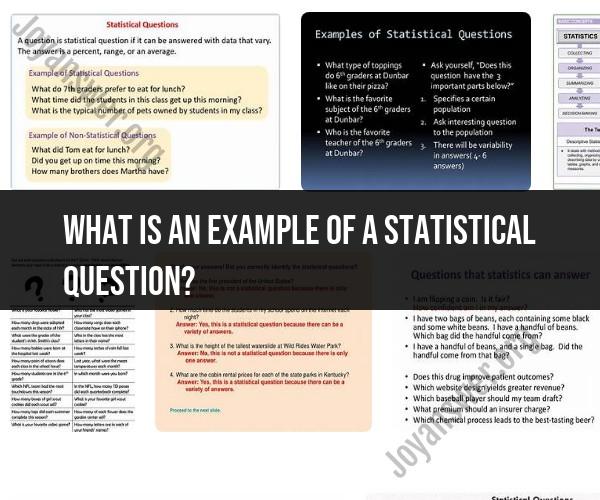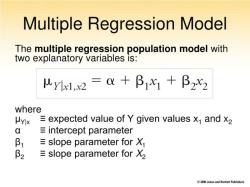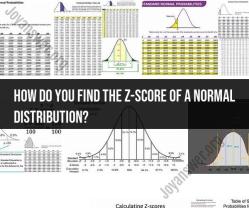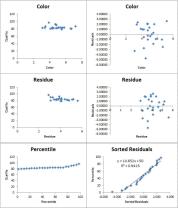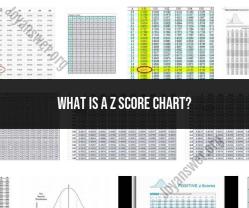What is an example of a statistical question?
A statistical question is a question that can be answered by collecting and analyzing data. It typically asks about a population or a sample and often begins with words like "how many," "how often," "what is the average," "what is the distribution of," or "is there a relationship between." Here are some examples of statistical questions:
How many hours per week do high school students spend on homework?
- This question seeks to quantify a specific behavior (hours spent on homework) among a group (high school students).
What is the average income of households in a particular neighborhood?
- This question aims to determine the central tendency (average income) of a specific population (households in a neighborhood).
How often do people in a city use public transportation for their daily commute?
- This question inquires about the frequency of a behavior (using public transportation) among residents of a city.
What is the distribution of ages among participants in a marathon race?
- This question seeks to understand the spread of ages among a specific group (participants in a marathon race).
Is there a relationship between the amount of sleep a person gets and their level of productivity at work?
- This question explores whether there is a statistical association or correlation between two variables (amount of sleep and productivity).
How many customers make online purchases during a specific time of day?
- This question aims to quantify a behavior (online purchases) over a certain time frame (specific time of day) among customers.
What percentage of students in a school passed a standardized math test?
- This question seeks to determine the proportion (percentage) of students who achieved a specific outcome (passing the math test) in a school.
Are there any significant differences in the heights of male and female students in a college?
- This question explores the existence of statistically significant differences in a characteristic (height) between two groups (male and female students).
Tips for Crafting Effective Statistical Questions:
Be Clear and Specific: Ensure that your question is clear and specific in what it is asking about. Ambiguity can lead to confusion in data collection and analysis.
Define the Population or Sample: Clearly specify the group or individuals you are interested in studying. This helps focus your question.
Use Measurable Terms: Use terms that are measurable and quantifiable. This allows you to collect data and obtain numerical answers.
Avoid Yes/No Questions: Statistical questions usually seek to collect data that can be analyzed quantitatively. Avoid questions that can be answered with a simple "yes" or "no."
Consider the Research Objective: Your statistical question should align with the research or analysis objective. What do you want to learn or discover through data collection and analysis?
Pilot Testing: Before collecting data on a large scale, consider pilot testing your question to ensure it can be effectively answered and that data collection methods are feasible.
Remember that statistical questions are the foundation of statistical analysis, and they guide the entire research or data collection process. They should be well-crafted to yield meaningful insights from the data collected.
Formulating Statistical Questions: Examples and Techniques
A statistical question is a question that can be answered by collecting and analyzing data. It is important to formulate statistical questions carefully so that they are clear, concise, and answerable.
Here are some examples of good statistical questions:
- What is the average age of students at this school?
- What is the correlation between height and weight?
- Is there a difference in the effectiveness of two different teaching methods?
- What is the impact of a new drug on patient survival rates?
Here are some tips for formulating statistical questions:
- Make sure your question is specific and measurable.
- Avoid asking questions that are too broad or too narrow.
- Consider your audience and what they need to know.
- Use clear and concise language.
Once you have formulated a statistical question, you can start to collect and analyze data to answer it.
Questioning Data: The Art of Crafting Statistical Queries
Questioning data is the process of using statistical methods to explore and understand data. It is an important part of the data science process.
To craft effective statistical queries, you need to have a good understanding of statistical methods and the data you are working with. You should also be able to think critically about your data and the questions you want to answer.
Here are some tips for crafting statistical queries:
- Start by identifying the specific question you want to answer.
- Choose the appropriate statistical method to answer your question.
- Consider the assumptions of the statistical method you are using.
- Interpret the results of your statistical analysis carefully.
Data Inquiry: A Closer Look at the Role of Statistical Questions
Data inquiry is the process of using data to answer questions and solve problems. It is an important part of the scientific method.
Statistical questions play a vital role in data inquiry. They help us to focus our inquiry and to develop a plan for collecting and analyzing data.
Here are some of the benefits of using statistical questions in data inquiry:
- Statistical questions help us to identify the specific information we need to collect.
- Statistical questions help us to choose the appropriate statistical methods for analyzing our data.
- Statistical questions help us to interpret the results of our data analysis and to draw conclusions.
Statistical questions are an essential part of data inquiry and the scientific method. By formulating effective statistical questions, we can gain valuable insights from our data.
